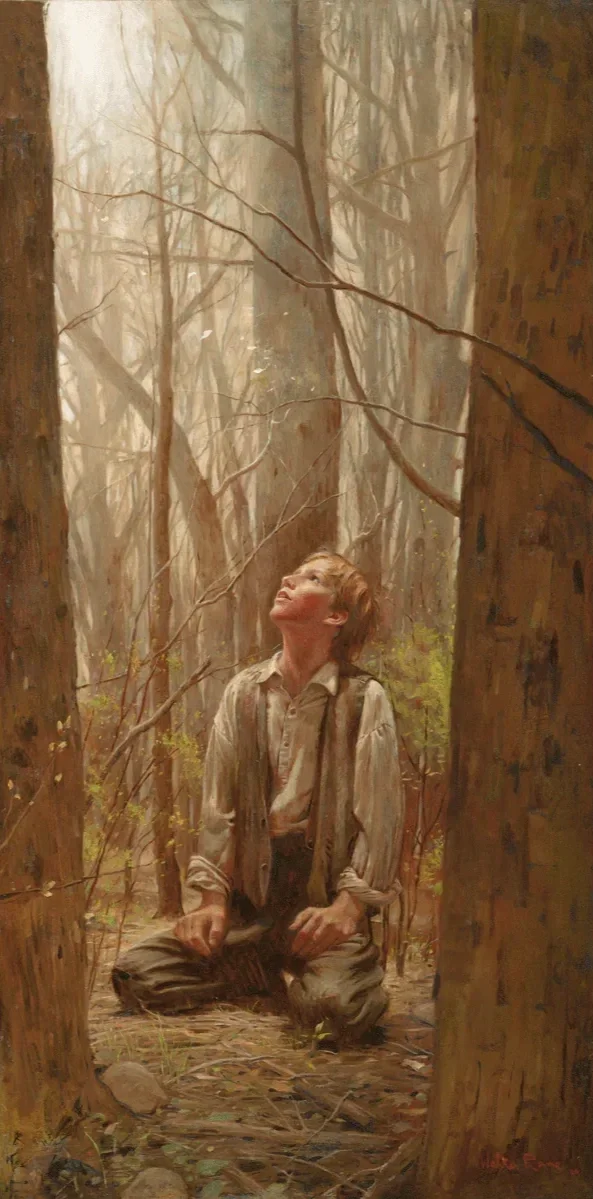November 24–30: D&C 135–136
He “Has Sealed His Mission and His Works with His Own Blood”
Gary Ernest Smith (American, born 1942)
Innocent Blood which Crieth from the Ground Against Them (1970)
Oil on canvas, 44.75 x 74.75 inches
Springville Museum of Art, Gift from John & Birdella Bearnson and Vern G. & Judy Swanson, 1997.020
Used with artist’s permission
Featured in Work & Wonder: 200 Years of Latter-day Saint Art
Art Companion
In Doctrine and Covenants 135, John Taylor declares that Joseph and Hyrum Smith have “sealed their testimony with their blood.” Gary Ernest Smith’s painting visualizes that declaration. Joseph lies at the center, pierced and bleeding, yet radiating light—his body itself becoming a lamp against the encroaching darkness. Smith removes all historical particulars of the mob, blending the attackers into anonymous silhouettes. This choice echoes the scripture’s emphasis: the identity that matters most is not the identity of those who hated him but the identity of the man who loved Christ enough to die for His work.
In Doctrine and Covenants 136, the Lord commands the Saints to “be faithful in tribulation” and promises that His people will not be forgotten. The painting, rooted in grief and yet luminous with hope, sits between those two truths: the tragedy of loss and the assurance that God’s work continues.
1. In what you have studied this year about Joseph Smith, what most impressed you about his character? How has studying about him impacted your impression of him?
2. This section includes some detailed instructions on how to organize companies to head west (D&C 136:2-11). What in the organization of the companies is applicable to the organization of wards and stakes in our present-day Zions across the world? What is applicable to the organization of families?
3. Jesus tells the Saints to "cease to contend one with another; cease to speak evil one of another; ... and let your words tend to edifying one another" (D&C 136:23-24). Watch for opportunities to edify someone else with your words. What might this look like? Can you think of someone who might benefit from your edifying words?
Seeing the First Vision in a new light
“All of a sudden, he was engulfed by love, and his posture changed.”
Walter Rane describes his life as a painter, and insights he gained into the scriptures while painting scenes from them.
For Children & Youth
Hi. This week is about a very sad part of Joseph Smith’s story. Joseph Smith restored the Church and taught people about it—even when it was dangerous. This painting shows the moment his life ended. The dark shapes around him show the people who hurt him, but notice how Joseph seems to shine with light. It reminds us that when someone follows Jesus, their goodness still shines, even after they are gone.
In Doctrine and Covenants 136, the Lord tells the Saints to keep going, help each other, and trust Him. Even though Joseph wasn’t there anymore, the people could still feel God’s love and guidance. We can, too.
1. If you were going to cross the plains with the pioneers and you got to bring a backpack filled with anything of your choice, what would you put into your backpack and why?
2. The pioneers prepared places to stay and planted seeds, not for themselves but for those who would follow them on the trail (D&C 136:9).. What things have you done to prepare for younger siblings or others who will follow you in growing up?
3. Jesus explains that all that we have is a stewardship from God? How have you been "a wise steward" with the things that are yours (D&C 136:27)?
Art Project
What can you include in your Thanksgiving celebration that demonstrates "praise the Lord with singing, with music, with dancing, and with a prayer of praise and thanksgiving" (D&C 136:28)? Write a "gratitude journal" entry that describes this activity.
New Transcriptions of the Book of Mormon
Work & Wonder Curator Brontë Hebdon explains two works that reimagine Book of Mormon text.







